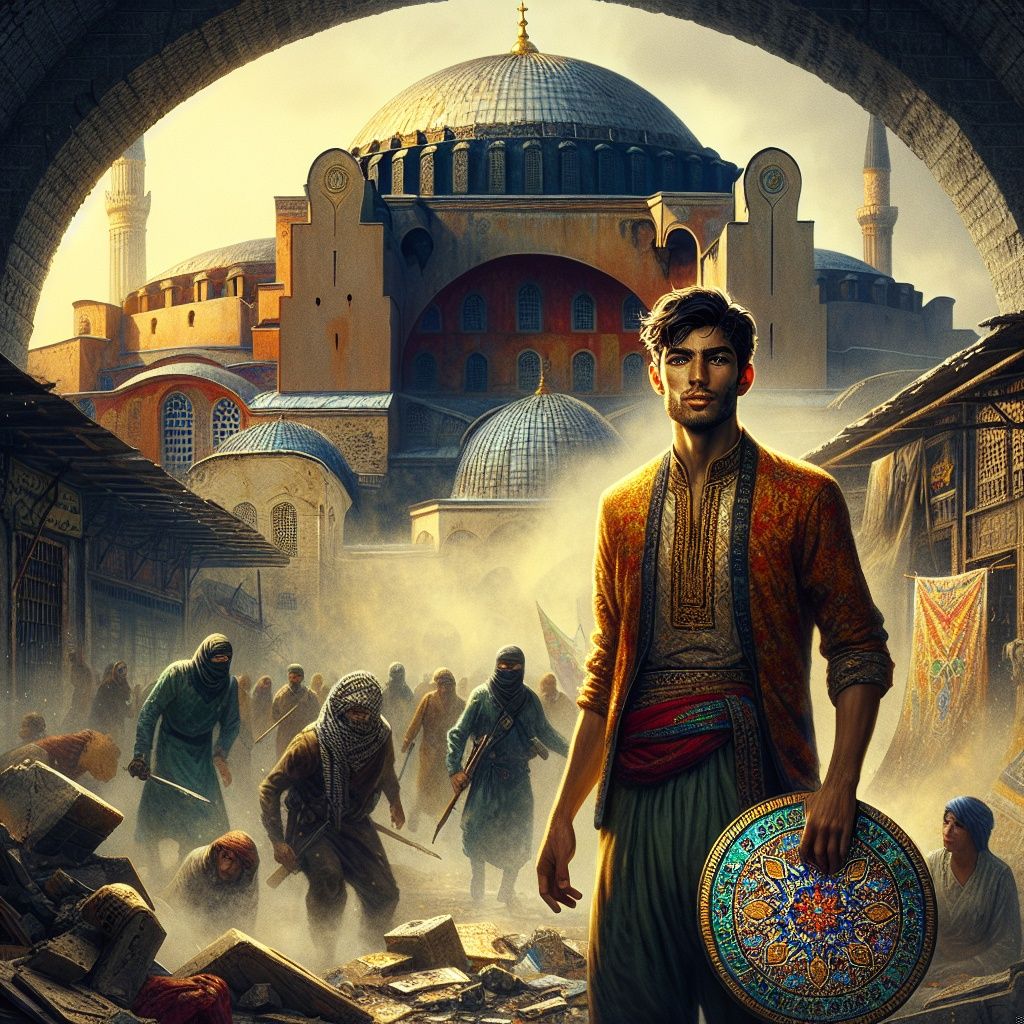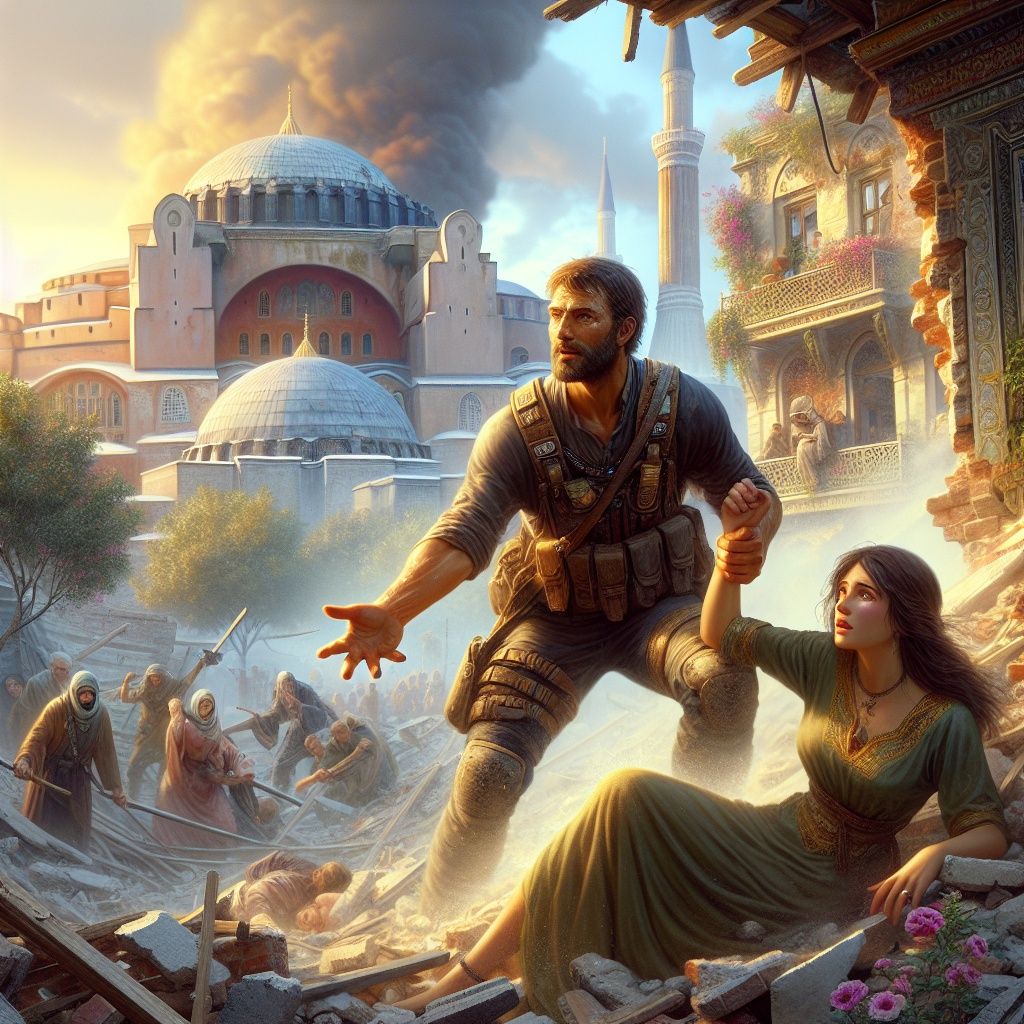In the shadow of the majestic Hagia Sophia, where the echoes of chants and prayers still got lost among the imposing columns, there lived a young man named Flavius. The son of a renowned mosaic artisan, Flavius had learned from an early age to appreciate beauty and to find harmony even in the everyday chaos of Constantinople. However, in those January days of the year 532, harmony seemed to have fled the city, leaving behind only rage and cries of revolt.
The Nika riots had erupted like an uncontrolled fire, and Flavius, although accustomed to the noise of the market and the city's bustle, felt overwhelmed by the intensity of the events. His father, once only concerned with the colors and shapes he carefully placed upon the walls of churches, now spent his days trying to protect the family workshop from the fury of the crowd.
One morning, while the city still slept under the weight of fear and anticipation, Flavius ventured outside their home's walls. The air was thick with heavy smoke, a mix of ash and despair. The streets, once full of merchants and travelers, were now deserted, save for the groups of rebels gathering in dark corners, murmuring plans of attack.

As he walked past the walls of the hippodrome, where rival factions of chariot racing fans – the Blues and the Greens – had congregated, Flavius heard a faint cry. It was a girl, trapped under the rubble of a shop destroyed during the riots. Without a second thought, the young man rushed to her, removing the stones that held her captive with his bare hands.

She was Anastasia, the daughter of a silk merchant, whom Flavius had often noticed in the market but never dared to approach. Her look, now filled with gratitude and fear, made him blush. Despite the chaos around them, in that moment, time seemed to stop for the two of them. After freeing her, Flavius led Anastasia back home, where her father, worried and relieved, thanked him with tears in his eyes. Flavius returned home, but the image of Anastasia did not leave him in peace. In the following days, the riots continued to intensify, and Flavius was torn between the desire to protect his family and workshop and the impulse to see Anastasia again. Eventually, Flavius and his father decided to move their valuable mosaics to a safe place, fearing that the workshop might be destroyed by the crowd's anger. While they traversed the streets with baskets full of fragile beauty, a group of rebels attacked them. In the fight that followed, Flavius was wounded, and his father fell, defending his son and their legacy. When Flavius woke up, he was in Anastasia's house, cared for by her family. While recovering, he learned that Emperor Justinian, in trying to quell the revolt, had promised reforms and had rebuilt the city, including the magnificent Hagia Sophia. Flavius and Anastasia, alongside his injured but alive father, watched as the city was reborn from ashes. From that troubled period, Flavius learned that beauty and passion could survive even in the darkest of times. He learned that courage and love could change destinies and that even amidst destruction, there could be hope. And when the new Hagia Sophia was completed, it was Flavius who placed the final piece of mosaic on its walls, alongside Anastasia, now his wife, symbolizing the rebirth of the city and their souls.


As he walked past the walls of the hippodrome, where rival factions of chariot racing fans – the Blues and the Greens – had congregated, Flavius heard a faint cry. It was a girl, trapped under the rubble of a shop destroyed during the riots. Without a second thought, the young man rushed to her, removing the stones that held her captive with his bare hands.

She was Anastasia, the daughter of a silk merchant, whom Flavius had often noticed in the market but never dared to approach. Her look, now filled with gratitude and fear, made him blush. Despite the chaos around them, in that moment, time seemed to stop for the two of them. After freeing her, Flavius led Anastasia back home, where her father, worried and relieved, thanked him with tears in his eyes. Flavius returned home, but the image of Anastasia did not leave him in peace. In the following days, the riots continued to intensify, and Flavius was torn between the desire to protect his family and workshop and the impulse to see Anastasia again. Eventually, Flavius and his father decided to move their valuable mosaics to a safe place, fearing that the workshop might be destroyed by the crowd's anger. While they traversed the streets with baskets full of fragile beauty, a group of rebels attacked them. In the fight that followed, Flavius was wounded, and his father fell, defending his son and their legacy. When Flavius woke up, he was in Anastasia's house, cared for by her family. While recovering, he learned that Emperor Justinian, in trying to quell the revolt, had promised reforms and had rebuilt the city, including the magnificent Hagia Sophia. Flavius and Anastasia, alongside his injured but alive father, watched as the city was reborn from ashes. From that troubled period, Flavius learned that beauty and passion could survive even in the darkest of times. He learned that courage and love could change destinies and that even amidst destruction, there could be hope. And when the new Hagia Sophia was completed, it was Flavius who placed the final piece of mosaic on its walls, alongside Anastasia, now his wife, symbolizing the rebirth of the city and their souls.

The Nika Riots took place against the Byzantine Emperor Justinian I in Constantinople, over the course of a week in 532 AD. These are considered the most violent riots in the city's history, resulting in nearly half of Constantinople being destroyed and tens of thousands of people dying. The causes of the riot included political tension, dissatisfaction with taxes and corruption, and rivalries between factions. After the riot, Justinian rebuilt the city and the Hagia Sophia, strengthening his power without facing any other major revolts until the end of his reign. The Nika Riots had a significant impact on the politics and stability of the Byzantine Empire, highlighting the importance of managing social and political tensions.


Comments
Post a Comment